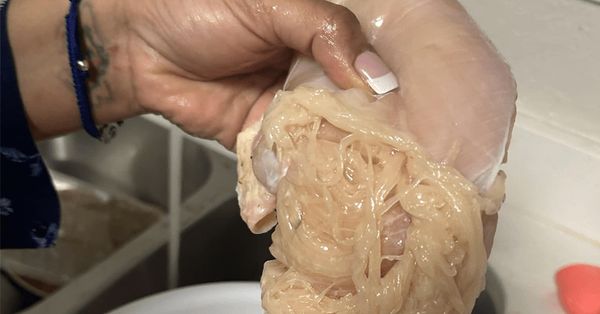
It was a shocking moment for a mother when the chicken she was preparing for dinner literally fell apart into strands of spaghetti. Sharing her experience on Facebook, the mom posted a picture of the raw chicken falling apart in her hands, making many question the authenticity of the meat. This unusual incident has sparked a viral reaction, with many users considering switching to a vegan diet. Keep reading to learn more about this peculiar phenomenon!
Alesia Cooper, from Irving, Texas, shared a disturbing photo of a chicken breast disintegrating into spaghetti-like strands on March 21st. Cooper posted, “I debated on posting this, but if I had to witness it, so do you all.” She explains that she was cleaning the chicken, as she normally does, when she returned to start cooking and found it transformed into what can only be described as spaghetti.

Cooper, who purchased the chicken breast from Aldi, a budget supermarket, suspects that the mysterious chicken is “fake meat.” Consequently, she jokingly adds, “I haven’t cooked bone-in chicken since.”
Social media users quickly ensued with their own theories, suggesting everything from 3D printed chicken to lab-grown meat. One user claimed that the peculiar chicken was a result of lab experimentation due to the bird flu and resource shortages. Another suggested it was GMO lab meat. However, a more reasonable theory points to the use of growth hormones, which can cause the chicken to grow too fast and subsequently result in the shredding effect.

According to The Wall Street Journal, “spaghetti meat” is allegedly caused by breeding chickens to grow faster, resulting in bigger breasts. This modification increases profitability for farmers, as there is more meat per bird. Dr. Massimiliano Petracci, a professor of agriculture and food science at the University of Bologna in Italy, confirms that these abnormalities are associated with rapidly growing birds.
While the idea of “woody breast” and “spaghetti meat” may be unsettling, industry experts maintain that consuming them poses no health risks to humans. However, the same cannot be said for the chickens themselves. The demand for white meat and specifically larger breasts has led to chickens with disproportionately large bodies and weakened legs.

In response to the increasing demand for chicken, the industry has adjusted accordingly. Broiler chickens now reach market weight at 47 days old, weighing 6.54 pounds on average. This represents a significant change from 1925 when broilers took 112 days to reach a market weight of 2.5 pounds. The desire for chicken nuggets, wings, sandwiches, and other inexpensive chicken products has fueled these changes.
While fast-food chains and some grocery stores have supported the demand for larger breast meat, there is a growing movement advocating for meat from slow-growth chickens. These companies argue that giving chickens more time to grow before slaughter leads to healthier and better-tasting meat.
The viral image of the noodled chicken has sparked disgust among online users, with some questioning the quality of the meat. This has encouraged others to consider alternative sources for their meat, such as local butchers or co-ops, where they can find humanely raised and higher quality options. Some users have even contemplated adopting a vegetarian or pescatarian diet due to concerns about factory farming and the mistreatment of animals.
It is truly unfortunate that factory farming practices can cause so much pain to these creatures during their short lives.






